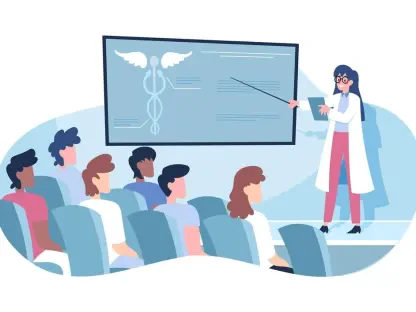In today’s discussion, we delve into the intricate world of public health policy with Faisal Zain, a notable figure in the realm of medical technology and healthcare innovation. His expertise doesn’t just stop at the advancement of medical devices; he also has a keen eye on the broader policies that shape healthcare delivery and public assistance programs. Faisal, your insights can shed light on the dynamics of entities like the Foundation for Government Accountability, often influencing critical legislative changes across the states.
Can you share insights about the Foundation for Government Accountability (FGA) and its overarching mission?
The FGA is a prominent conservative think tank based in Florida, primarily focused on reforming public assistance programs across the United States. Their mission revolves around reducing dependency on government benefits and promoting self-sufficiency among citizens. They aim to achieve this by advocating for policy changes that limit access to programs like SNAP and Medicaid, asserting that this would encourage more individuals to seek employment and lift themselves out of poverty.
What was the inspiration behind FGA’s creation, and what goals did it initially set out to achieve?
FGA was founded in 2011 with the intention of curbing what its founders saw as an overreliance on government welfare programs. Initially, their goal was to craft policies that would “free millions from government dependency” and foster an environment where individuals could pursue the American Dream without relying heavily on state-sponsored aid. This vision was born from a mix of economic and social motivations, aiming to create a more self-reliant population.
Can you outline the foundational principles FGA adheres to in its public assistance program reforms?
FGA’s approach is rooted in principles of fiscal responsibility, efficiency, and accountability. They believe that reducing the size and cost of government assistance programs can lead to a more robust economy by reallocating resources more effectively and encouraging personal responsibility. Moreover, they argue that stringent eligibility requirements for aid programs can ensure that only those truly in need receive support, thereby conserving taxpayer dollars.
How does FGA plan to engage with the current administration led by Robert F. Kennedy Jr.?
Under the current administration, FGA sees an opportunity to further its agenda significantly. With Kennedy’s backing on initiatives like the “Make America Healthy Again” platform, which aligns with some of FGA’s key views on SNAP restrictions, they anticipate more favorable federal policies that could ease the introduction of their reforms at the state level. By working closely with policymakers, they aim to shape legislation that mirrors their advocacy for public assistance reform.
In FGA’s perspective, how does saving taxpayer dollars link with the goal of reducing government dependency?
FGA posits that by implementing policies that limit government assistance, they can effectively decrease the fiscal burden on taxpayers. They argue that savings accrued from reduced spending on welfare can be redirected towards other areas that may yield higher economic returns. The belief is that creating more stringent criteria for program eligibility not only saves money but also motivates individuals to seek employment and be less dependent on government aid.
What does FGA mean by “making government accountable,” and how does it manifest in their policies?
The notion of accountability is central to FGA’s objectives. They advocate for transparent and efficient use of public funds, where every dollar spent is justified. Their policies often focus on tightening control over welfare programs, ensuring that assistance reaches those who qualify under clearly defined criteria. By doing so, they aim to eliminate waste and fraud, thereby optimizing the impact and efficiency of government aid.
Could you detail the type of legislation FGA promotes, especially concerning SNAP restrictions?
FGA is known for advocating legislation that imposes restrictions on what can be purchased with SNAP benefits, focusing on excluding unhealthy foods like soda and candy. They argue that such measures not only improve public health but also ensure that taxpayer dollars are spent on nutritious options that align with broader health objectives. This approach has seen varying levels of success across the states, as they push for state-level reforms to eventually influence federal policy changes.
What impact do SNAP restrictions have on public health and government spending, according to FGA?
FGA contends that SNAP restrictions can lead to healthier dietary habits among recipients by restricting access to sugary and unhealthy foods. This, in turn, could reduce long-term healthcare costs related to diet-induced conditions such as diabetes and heart disease. From a fiscal perspective, they argue that better health outcomes could translate into reduced healthcare spending, thereby supporting their goal of cutting government expenditure.
Can you elaborate on the process states must undertake to implement SNAP restrictions?
To implement SNAP restrictions, states need to secure federal approval through a waiver process, as SNAP is federally regulated. This involves presenting a case to federal agencies, demonstrating how the proposed restrictions would benefit public health and align with SNAP’s overall objectives. However, gaining such approvals can be challenging, and the process requires careful navigation of federal regulations and political landscapes.
How does FGA address situations when states face challenges in securing federal approval for SNAP restrictions?
FGA often supports states in advocating for these changes by providing data, research, and strategic advice to bolster their applications. They may also work with policymakers to revise proposals to better align with federal standards or push for legislative change at the federal level that could ease the pathway for states to implement these restrictions without requiring onerous approvals.
What approach does FGA take in influencing federal policies through state-level legislation?
FGA employs a strategic, state-by-state method to gradually build momentum for their legislative goals. By accumulating reforms at the state level, they create a groundswell of change that can exert pressure on federal agencies to reconsider or reshape national policies. This bottom-up approach allows states to act as testing grounds for policies that, if successful, could be scaled nationally.
What techniques does FGA utilize to encourage the passage of legislation in various states?
FGA engages in comprehensive lobbying efforts, providing lawmakers with research, talking points, and potential legislative templates to streamline the drafting process. They also build alliances with sympathetic legislators and advocacy groups to bolster their legislative campaigns. Their strategy often involves highlighting data on potential cost savings and public health benefits to gain broader support from stakeholders.
How does FGA’s vision align or contrast with the current health policies introduced by the Trump administration?
FGA’s vision closely aligns with the Trump administration’s emphasis on reducing dependency on public assistance and promoting self-sufficiency. However, while the administration may focus broadly on healthcare, FGA specifically targets entitlement reforms with detailed proposals aimed at altering eligibility and program design to achieve these ends. Their targeted approach often complements the administration’s broader policy goals.
Critics argue that FGA’s proposals could adversely affect those reliant on public benefits. What are your thoughts on this stance?
Critics often point out that FGA’s stringent policy proposals could marginalize vulnerable populations by making it harder for them to access necessary support. They argue that while fiscal savings are a goal, the human cost of reduced access to nutrition and healthcare could exacerbate poverty and ill health. It’s essential to find a balance between fiscal responsibility and ensuring aid reaches those who need it most.
In what ways does FGA’s policy implementation impact community resources like food banks?
The policies proposed by FGA, especially those that limit SNAP eligibility or benefits, can often lead to increased demand for local resources such as food banks. As people struggle to meet their dietary needs due to restricted assistance benefits, they may turn to these community resources, potentially overwhelming them. This ripple effect highlights the importance of considering the broader community impact of policy changes.
Can you discuss the effect of the HOPE Act in Kansas, which FGA was instrumental in drafting?
The HOPE Act in Kansas introduced several restrictions on public assistance, which led to a substantial decline in SNAP participation as eligibility criteria became more stringent. While supporters laud it for encouraging self-reliance, critics cite the resultant increase in demand at food banks and charities, arguing that it left many without adequate support. The act is often seen as a flagship example of FGA’s policy in action, illustrating both its intended and unintended consequences.
What challenges do opponents of FGA’s proposals foresee, and how might these affect future policy decisions?
Opponents argue that the complexity and rigidity of FGA’s proposals may lead to administrative burdens and barriers for beneficiaries, causing some who genuinely need assistance to fall through the cracks. They caution that such policies might strain local economies, increase poverty, and lead to greater health disparities, potentially necessitating costly interventions down the line.
How does FGA use data and polling to influence policy at the state level?
FGA leverages data and polling as pivotal tools to influence state policies. By presenting research that underscores the financial and social impacts of current versus proposed policies, they aim to sway public opinion and legislative action. Data-backed arguments provide a compelling narrative that supports their reform agenda, making it harder for critics to dismiss their proposals without countering with equally robust evidence.
Could you explain the idea behind focusing on “redder and better” states as part of FGA’s strategy?
The “redder and better” approach targets states with politically conservative leadership likely to be receptive to FGA’s initiatives. By concentrating efforts in these states, FGA seeks to ensure smoother legislative pathways and create successful case studies that can inspire similar reform efforts elsewhere. This strategy maximizes their influence by aligning with like-minded policymakers and amplifying their success stories.
In what ways does FGA collaborate with lawmakers in conservative states like Idaho to promote its agenda?
In Idaho, FGA works closely with lawmakers by providing legislative drafts, data, and strategic insights tailored to the state’s political climate and regulatory environment. They engage local stakeholders, offering resources and support to craft policies that reflect both FGA’s objectives and the state’s needs. This close collaboration helps cement their influence and successfully advance their legislative agenda.
Could you share success stories or challenges FGA has encountered in its legislative pursuits?
FGA has seen successes in states like Idaho and Kansas, where their policies have been enacted and served as models for similar initiatives in other states. However, they’ve also faced challenges, such as vetoes or resistance from leaders who fear the socioeconomic impact of their reforms. These experiences offer valuable lessons in navigating the complexities of policy advocacy and adapting strategies to achieve their objectives.
How does FGA deal with opposition from organizations that stand against its policy propositions?
FGA addresses opposition by reinforcing their proposals with robust data and highlighting success stories from states where their policies have been implemented. They engage in active dialogue with critics to understand concerns and revise strategies to gain wider acceptance. Building coalitions and aligning with other advocacy groups also helps counteract opposition.
Do you have any advice for our readers?









